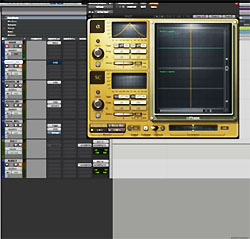
4. Crazy Experiments
Sometimes you just want to go crazy and mix some stuff up. Necessity is the mother of invention but creativity is the papa.
Grabbing two or three drums and playing with the pitch, envelope, phase, distortion and tone can yield very unique and exciting results.
One of my favorite ways to do this is to grab a drum and throw an extreme effect on it. I may bit crush the snot out of it. Maybe I’ll use a phaser of some sort. Or some kind of vocoder/talkbox effect. Or maybe some extreme EQ. Anything that piques my interest.
Then I’ll grab another drum and use it to “anchor” the crazy drum into something more accessible for the genre or song I am working on.
6. Don’t Forget Phase
Phase is of paramount importance when layering drums.
If you grab two kick drums, even if they are completely different, you may find they interact on a physical phase-based level. This tends to be more noticeable with lower frequency drums. Yet even higher frequency drums will still interact in this manner.
Any time you are layering drums, do a polarity flip on one of them. What changed? Did the drums become ghostly and hollow? Did the drums suddenly become fuller? Which sounds better?
If flipping the polarity makes a dramatic change — particularly with layered kicks — then you’re in good shape. That means you are either directly in or out of phase, and you can adjust the polarity accordingly. You may be in trouble if you don’t notice much of a difference.
With snares this isn’t as much of a concern. With kicks however, this is a strong indication that your kicks are ninety degrees out of phase. What this means is that the micro-timing of the kicks are not in optimal position.
You can adjust this by experimenting with tiny timing changes. Delay one kick by a half a millisecond and see how that changes things. Then try delaying the other. Hopefully you’ll find a spot where it locks together.
Conclusion
The art of drum layering is a bit more complex than it first seems. How you choose to go about it is very personal to your sensibilities. And the potential pitfalls along the way require a developed ear to suss out.
Practice and experimentation are the recipe for success.
Matthew Weiss engineers from his private facility in Philadelphia, PA. A list of clients and credits are available at Weiss-Sound.com. To get a taste of The Maio Collection, the debut drum library from Matthew, check out The Maio Sampler Pack by entering your email here and pressing “Download.”
Also be sure to visit The Pro Audio Files for more great recording content. To comment or ask questions about this article, go here.
